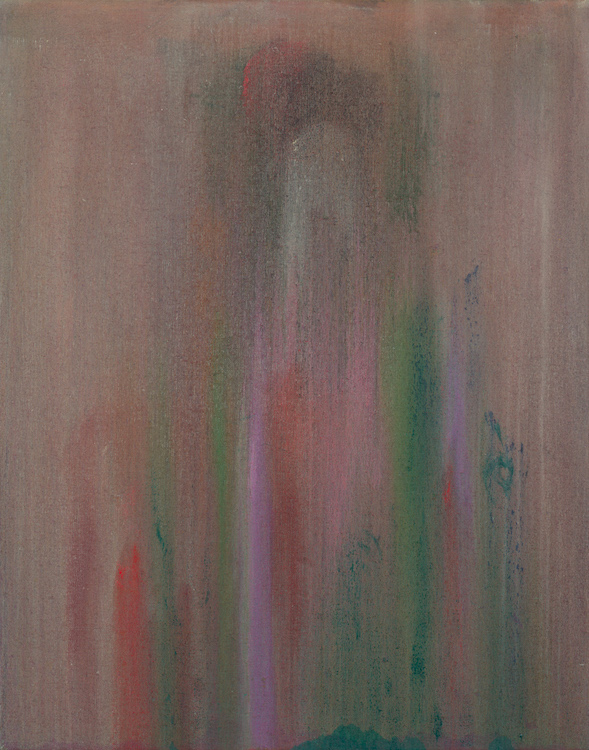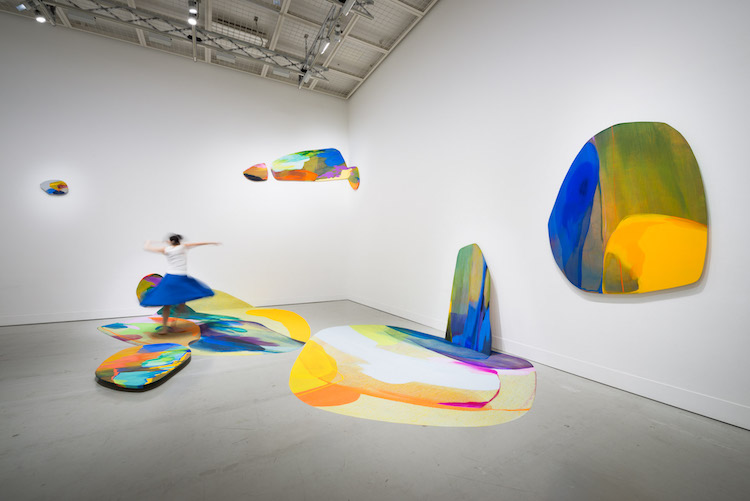流 麻二果 NAGARE Manika

《渡河》2020年 キャンバス、油彩 89.4×81.0㎝ 個人蔵 撮影:加藤健
To the Otherside, 2020, Oil on canvas, 89.4×81.0㎝, Private collection, Photo by KATO Ken
流 麻二果 NAGARE Manika
1975年、大阪市生まれ。香川で育つ。東京都に在住、活動。
軌跡と集積
絵画という形式は、もはや美術において使い古されたものかもしれない。しかし、 カンヴァスに油絵具を用いたアナクロニックともいえる絵画技法を用いて流麻二果は挑戦を続けている。視覚がとらえた具体的な像を出発点として、彼女の画面は変容を繰り返し、いくつもの色彩が織り成す抽象的なイメージが生み出される。その過程で視覚像は解体され、経験された色彩が残像のようにカンヴァスの上で構成されていく。さらに近年は、壁に架けられた矩形の作品という伝統的な絵画の形式を問い直すべく、作品の画像をプリントした布を展示会場に用い、 鑑賞者があたかも絵画の一部となるように感じる試みや、ダンスパフォーマンスとのコラボレーションを通して、壁を飾る絵画作品だけではなく、その豊かな色が彩る空間そのものを作り出そうとしている。
本展覧会『色を追う/Tracing the Colors』は、流がこれまで挑んできた色彩という絵画の基本要素を通して、印象派をはじめとする近代美術の巨匠たちと時を越えた対話を行う試みである。ポーラ美術館が収蔵するピエール·オーギュスト·ルノワール〈水のなかの裸婦〉(1888年)における薄い絵具の重なりによって肌の透明感を表現する技法に想を得た《人肌/Skin Warmth》(2017年)、フィンセント·ファン·ゴッホ《草むら》(1889年)にみられる絵画の「水平/垂直」という問題から生まれた《照降なし/Neither Rain nor Shine》(2017年)の制作を通して、流は一世紀以上前に制作された作品に向き合い、 その上に自らのオリジナリティを模索している。
そして、その対話と探究のなかで彼女は新たなシリーズ「色の跡」を生み出した。これは先行する2点に用いた絵具を一枚のカンヴァスに薄く塗り重ねた《色の跡/Traces of Colors》(2017年)を端緒として、巨匠たちの絵画に見出した色彩を層として重ねた連作である。画面の上に幾層にも重ねた油絵具は、モネやルノワール、ファン·ゴッホの作品から流自身が知覚した色彩の軌跡を物語る。ここで彼女の視覚の残像は、物質的な重なりとして我々の前に現れてくる。それは、これまでひたむきに色彩と、 そして絵画に向き合い続けてきた流の時間と経験の集積でもあるだろう。
東海林 洋(ポーラ美術館学芸員)、HIRAKU PROJECT VOL.3 流 麻二果『色を追う/Tracing the Colors』展リーフレット、ポーラ美術館、2018年
Born in 1975, Osaka city, Japan. Grew up in Kagawa Prefecture. Lives and works in Tokyo, Japan.
Tracings and Accumulations
While painting may currently be thought of as out of favor, Manika Nagare has chosen this seemingly anachronistic technique of applying paint to canvas as her mode of expression. Her process involves the repeated transformation of concrete images to create abstract forms of interwoven colors. The dismantling of original visual images results in colors appearing on canvas as ‘after images. By incorporating fabric printed with her painted images, Nagare further distances herself from conventional ideas of a painting as a rectangle affixed to a wall. In the exhibition space, viewers might feel as ‘collaborators’ in a dance performance. More than merely wall decorations, Nagare’s paintings create a space rich in color.
The intention of Tracing the Colors is to traverse time in order to initiate dialogue between contemporary art and modern art, mainly Impressionism, based on Nagare’s particular use of color, a basic element of painting. Nagare’s Skin Warmth (2017), for example, takes a hint from Pierre Auguste Renoir’s technique in Young Woman Bathing (1888) of rendering transparent skin by overlapping thin layers of paint. Nagare’s Neither Rain nor Shine (2017) has its origin in the artist’s personal exploration of the ‘horizontal/vertical’ problem present in Vincent van Gogh’s Clumps of Grass (1889) done more than a century earlier.
Nagare began her Tracing of Colors series through dialogue with the two paintings. Traces of Colors (2017), the first in her series, incorporates the layering of thin color on canvas. The physical overlapping of oil paint on Nagare’s canvases recalls Monet, Renoir, and van Gogh, and also reveals the trajectory of Nagare’ s owns perception of color as well as her ‘after image’ vision. It represents accumulation of time and experience in Nagare’s dedicated interaction with painting and color.
SHOJI Yoh (Curator, Pola Museum of Art), from the leaflet of HIRAKU PROJECT VOL.3, Manika Nagare, Tracing the Colors, Pola Museum of Art, 2018
更新された最新の情報は、作家のウェブサイトとSNSをご覧ください。
Please refer to the following artist’s website and social media for new updates.
https://manikanagare.com
https://www.instagram.com/manikanagare/
https://www.facebook.com/nagare.manika

《色の跡:松岡静野「舞妓」》2020年 油彩、カンヴァス 52×41㎝ 練馬区立美術館蔵 撮影:加藤健
Traces of Colors: Maiko by Matsuoka Shizuno, 2020, Oil on canvas, 52×41㎝, Collection of Nerima Art Museum, Tokyo, Photo by KATO Ken

《よそごとでない地》2015年 ミクストメディア インスタレーション サイズ可変 資生堂ギャラリー 撮影:加藤健
Too Close to Home, 2015, Mixed media, size variable, Installation view at Shiseido Gallery, Tokyo, Photo by KATO Ken

《重なる》2014年 油彩、カンヴァス 300×650㎝ 港区立麻布図書館 撮影:鈴木拓也
Layers, 2014, Oil on canvas, 300×650㎝, Azabu Library, Tokyo, Photo by SUZUKI Takuya

